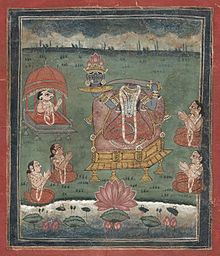Chinnamasta
Chinnamasta (Sanskrit: छिन्नमस्ता, Chinnamastā = „deren Kopf (masta) abgeschnitten (chinna) ist“) ist eine tantrische Mahavidya im Kontext des Hinduismus. Ihren Kopf soll sie sich in einem Anfall von Selbstopfer selber abgetrennt haben.
Ursprung und Verbreitung
Wahrscheinlich fußt die gedankliche Ausgestaltung der Göttin auf volksreligiösen und tibetisch-buddhistischen Grundlagen, die in Gestalt der Chinnamunda bereits im 7. Jahrhundert verbreitet waren; sie ist auch als eine Form der Vajrayogini bekannt.
Die Verehrung von Chinnamasta ist hauptsächlich im weitgehend ländlichen Norden des indischen Subkontinents (Bengalen, Nepal, Rajasthan) verbreitet; von dort fand sie auch ihren Weg in die Städte.
Ikonographie
In der Ikonographie erscheint sie zumeist als nackte junge Frau mit einem Schwert in der einen und ihrem abgehackten Kopf in der anderen Hand. Aus ihrem Hals fließen drei Blutströme – einer davon in ihren eigenen Mund, die anderen beiden in die Münder der sie flankierenden Yoginis. Sie steht auf Kama, dem Gott der sexuellen Liebe, der sich unter ihr mit seiner Frau Rati vereinigt. Diese beiden liegen auf einem Lotus, der oft auf einem Einäscherungsplatz liegt.
Bedeutung
Die Ikonographie der in hohem Maße unorthodoxen und widersprüchlichen Göttin verbindet Leben, Tod und Sexualität; mit ihrem eigenen Blut nährt sie ihre Anhänger.
Siehe auch
Literatur
- Neela Bhattacharya Saxena, Neela (2011). "Mystery, Wonder, and Knowledge in the Triadic Figure of Mahāvidyā Chinnamastā: A Śākta Woman's Reading". In: Tracy Pintchman und Rira D. Sherma: Woman and Goddess in Hinduism: Reinterpretations and Re-envisionings. Palgrave Macmillan 2011, ISBN 978-1-349-29540-1.
- Elisabeth Anne Benard: Chinnamastā – The Aweful Buddhist and Hindu Tantric Goddess. Motilal Banarsidass 2010, ISBN 978-81-208-1748-7.
- David Kinsley: Indische Göttinnen. Weibliche Göttinnen im Hinduismus. Insel-Verlag, Frankfurt 1990, S. 232ff, ISBN 3-458-16118-X.
Weblinks
- Chinnamasta – Skulptur + Infos (englisch)
- Chinnamasta – Bilder + Infos (englisch)
Auf dieser Seite verwendete Medien
Calcutta art studio Chinnamasta
"This beautiful work of art is an hand made unique and ancient traditional miniature painting from the Bundi School (one of the most prestigious school of the traditional art of Rajasthan in India). This is an original painting, not a copy, painted more than 238 years ago around year 1775. It measures 6,3 x 7,87 inches (16 x 20 cm) for the painting itself, not including painted frame.
This painting was done with opaque water color made with natural pigments from different stones and real gold, on hand-made paper.
It represents the goddess chinnamasta with severed head. This is a tantra based subject. Mostly this goddess depicted in fierce form but here she is depicted in a benign form, sitting on a golden throne wearing red and orange dress holding a sword in her left hand, in the right hand her own severed head with lotus crown and opened third eye on forehead from which comes lightning of direct perception that destroys all duality and negativity.
Devotees sitting both side and praying, in background a special character appear with head of ram and human body, quite possible its an icon of ego In humans. A big lotus in the pond is symbol of wisdom and purity."Autor/Urheber: Jean-Pierre Dalbéra from Paris, France, Lizenz: CC BY 2.0
Petit temple dédié à la divinité tantrique Chhinnamasta
___________
Le temple de Changu Narayan est considéré comme le plus vieux du Népal, il possède un toit en forme de pagode à 2 étages. Il a été reconstruit probablement au XVIIème siècle mais avec des éléments architecturaux et décoratifs beaucoup plus anciens.
Ce temple dédié à Narayan est au sommet d'une montagne considérée comme sacrée depuis 464 après notre ère comme en atteste une référence écrite à ce site qui date du règne du roi Licchavi Mandeva mais le site était probablement sacré depuis le 3ème siècle.
Dans la cosmologie hindoue, Vishnou lorsqu'il repose sur le serpent Ananta (Shesha) est appelé Nârâyana (Narayan) c'est à dire "Reposant sur les eaux" ou "Demeure-de-l'Homme" ou encore "Demeure-du-savoir". Nârâyana, qui signifie aussi "Refuge universel", est une des 24 images de Vishnou d'après le Rupa Mandana.
Article de Wikipedia sur Narayana (Narayan au Népal) fr.wikipedia.org/wiki/Narayana
Article de Wikipedia sur Changu Narayan
en.wikipedia.org/wiki/Changu_Narayan




